Intel Arrandale: 32nm for Notebooks, Core i5 540M Reviewed
by Anand Lal Shimpi on January 4, 2010 12:00 AM EST- Posted in
- Laptops
Clarkdale is the desktop processor, but Arrandale is strictly for my notebooks. The architecture is the same as Clarkdale. You've got a 32nm Westmere core and a 45nm chipset on the same package:
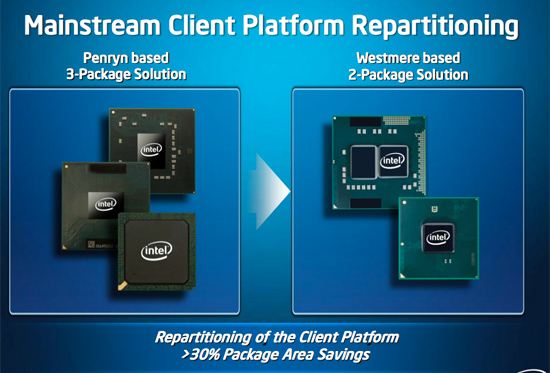
The two-chip solution does matter more for notebooks as it means that motherboards can shrink. Previously this feature was only available to OEMs who went with NVIDIA's ION platform (or GeForce 9400M as it was once known). This is the first incarnation of Intel's 32nm process so it's not quite as power optimized as we'd like. The first mainstream Arrandale CPUs are 35W TDP, compared to the 25W TDP of most thin and light notebooks based on mobile Core 2. Granted the 35W includes the graphics, but it's not always going to be lower total power consumption (more on this later).
The Arrandale lineup launching today is huge. Intel launched 7 Clarkdale CPUs, but we've got a 11 mobile Arrandale CPUs coming out today:
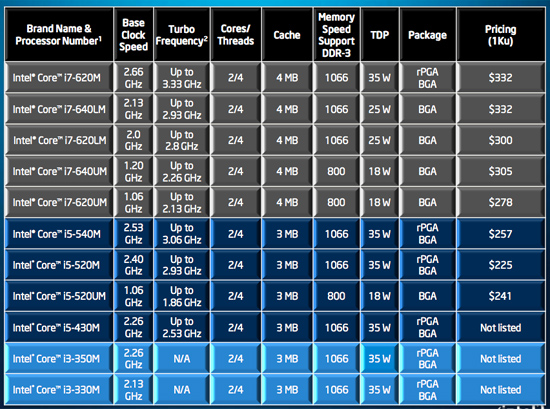
The architecture is similar to Clarkdale. You get private 256KB L2s (one per core) and a unified L3 cache for the CPU. The L3 is only 3MB (like the Pentium G9650) on the Core i5 and Core i3 processors, but it's 4MB (like the desktop Core i5/i3) on the mobile Core i7. Confused yet? I'll have to admit, Intel somehow took a potentially simple naming scheme and made it unnecessarily complex. We also get some low-voltage parts that have 18W TDPs. They run at low default clock speeds but can turbo up pretty high.
Turbo is hugely important here. While Clarkdale's Turbo isn't exactly useful, the TDPs are low enough in mobile that you can really ramp up clock speed if you aren't limited by cooling. Presumably this will allow you to have ultra high performance plugged-in modes where your CPU (and fans) can ramp up as high as possible to get great performance out of your notebook. Add an SSD and the difference between a desktop and a notebook just got even smaller.
Arrandale does have one trick that Clarkdale does not: graphics turbo.
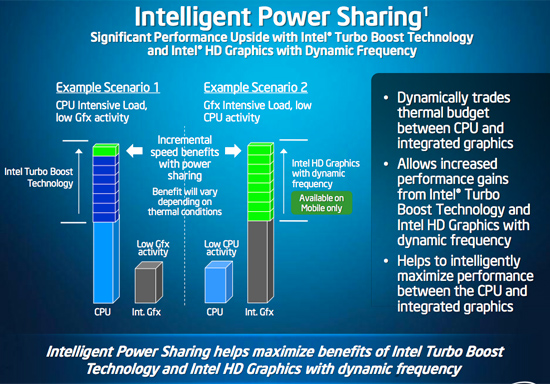
GPU bound applications (e.g. games) can force the CPU part of Arrandale into a low power state, and the GPU can use the added thermal headroom to increase its clock speed. This is a mobile only feature but it's the start of what will ultimately be the answer to achieving a balanced system. Just gotta get those Larrabee cores on-die...
Chipsets are even more complicated on the mobile side:
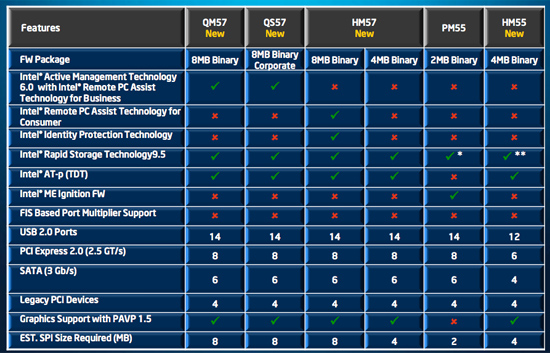
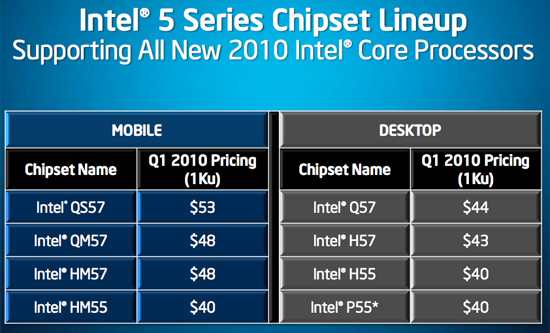










38 Comments
View All Comments
silverblue - Friday, January 8, 2010 - link
Hmm.silverblue - Friday, January 8, 2010 - link
Nope, it's just me (damned similar names)... however, the Clarkdale article has vanished from the front page. :|dnenciu - Thursday, January 7, 2010 - link
I don't know why are reviewers so happy about Arrandale.You basically get 20% improvement compared to the same "clockspeed" c2d.
What about the fact that Arrandale only goes 2.53Ghz and 2.66 for the extreme edition.
C2D already goes to 3.33Ghz
Yes turbo boost increases the 2.53Ghz to 3.06 but that is only if one core is used and the laptop has proper cooling.
The c2d at 3.06 Ghz can run two cores at that speed.
So what we are seeing is last years performance and same battery life.
And also last years integrated GPU. That now you don't even have a choice to replace with a 9400m.
I really feel underwhelmed by this chip release.
Lets hope that they can improve it in the next release because for me this one is a big flop. :(
iwodo - Monday, January 4, 2010 - link
I record CoreiX series was proved to be much more efficient then C2D in some previous Anand article. Now we are actually getting different results. So Westmere gets more performance by using more energy and transistors.And this isn't an fair comparison either, C2D platform uses an 65nm of IGP and 45nm of CPU. While Westmere gets one process node improvement in both.
So in terms of pure Power / Peformance, it looks like C2D still has an edge. I would love Intel make an 32nm of C2D. ( Which would play well with ION2 and Apple would love it. )
I hope SandyBridge would come soon as an True successor to C2D. Nahamlem to me is just an CPU made for Server.
Side Notes - Intel GPU, although performance is fast enough in lowest settings, still gives worst Image Quality compare to other IGP. Which gains an unfair advantage. I hope some Internet review will point this out.
JarredWalton - Monday, January 4, 2010 - link
On the desktop, Core i7 (and particularly Lynnfield) provided great idle power results. My testing of Core i7 notebooks on the other hand shows that the quad-core variant is a power guzzler.zicoz - Monday, January 4, 2010 - link
How does this compare to the Clarkdale on the HTPC front? Does it support LPCM and bitstreaming? I have this dream of building a HTPC from laptop parts, and if this supports the same stuff as the Clarkdale then this could be it.jasperjones - Monday, January 4, 2010 - link
Anand writes:"The first mainstream Arrandale CPUs are 35W TDP, compared to the 25W TDP of most thin and light notebooks based on mobile Core 2. Granted the 35W includes the graphics, but it's not always going to be lower total power consumption."
--
From the benches shown here I infer: the 540M is substantially faster than the fastest available C2D. Which is to say, the T9900 (unless I forget some Core 2 Extreme model) whose TDP is 35W. There is no P-series C2D that provides the performance of the 540M. Thus, an apples-to-apples comparison is really vs. a T9900 (or Core 2 Extreme) which has 35W TDP and *no* integrated graphics.
And even if you aren't d'accord with my statement above: logically, you can't just compare the P8xxx/P9xxx models' TDP of 25W with Clarksfield's TDP of 35W. After all, Clarksfield includes essentially all Northbridge functionality. The Northbridge for Penryn is rated 12W TDP. So, really, 35W < 25W + 12W = 37W (or, 35W < 35W + 12W = 47W).
jasperjones - Monday, January 4, 2010 - link
^^^ of course, I mean Arrandale, not Clarksfield.JarredWalton - Monday, January 4, 2010 - link
Even then, TDP ratings aren't actual power requirements. They're more like a limit on the thermal output, so you need 35W of cooling on a 35W CPU, even though at idle it probably uses only 5W.As far as performance, Arrandale in most cases is about 20% faster. The T9900 is 3.06GHz compared to 2.53GHz on the P8700, which is a 20% performance boost. That would make the T9900 about equal to a 540M. At that level of performance, I would expect the battery life advantage to be more like 5-10% for Arrandale. (Despite the 35W vs. 25W TDP, my experience is that for typical battery life testing scenarios, the 35W TDP CPUs are not substantially worse than 25W CPUs.)
Wolfpup - Monday, January 4, 2010 - link
I'm still surprised that we don't get 32nm quads yet, though I suppose from Intel's perspective it makes sense-probably make the most from their mid range "high end dual cores".I'm glad to see there are some new chipsets with this too. PM55 has USB problems, that OEMs don't seem to be addressing super well. There's some talk that the newest drivers from Intel combined with a hotfix from Microsoft that isn't even for this chipset fixes it, but not 100% sure if it really does.